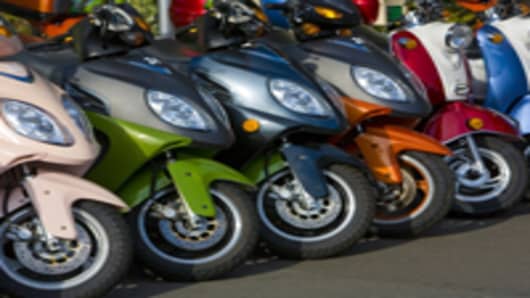A new scooter rolls off the Honda assembly lines at Manesar in the north Indian state of Haryana every 20 seconds. Yet the Japanese-owned company cannot produce enough of its scooters and motorcycles to supply the strong demand in the world’s fastest growing large economy after China.
It has just opened a new plant in neighboring Rajasthan, and has plans for another in Bangalore in south India to supply a youthful population where mobility translates into a higher earning opportunity.
Yet in recent months each of the 5,500 vehicles that roll off the Manesar production lines each day has become markedly more expensive to make.
Two wheelers are one of the fastest growing segments of the economy, alongside mobile phones and fast moving consumer goods. As such the sector highlights the vulnerability of manufacturers in India as the country wrestles with rising inflation by increasing interest rates and potentially strangling growth.
V Sridhar, head of the operations at the Manesar plant, explains that rising input and energy costs have put pressure on the company’s margins. Nearly 100 percent of Honda’s scooters and motorcycles are produced from raw materials sourced in India and their prices have risen precipitously.
“Raw material prices are all on the increase; steel prices, aluminum, copper and rubber are all going up,” says Mr Sridhar.
Steel and rubber prices have risen 20 percent over the past year but Honda has not passed costs on to consumers because of strong competition from rivals including Bajaj, Hero and Suzuki .
Labor costs, too, are rising sharply. While the cost of unskilled labor at the plant is rising 10 percent a year to keep pace with core inflation, an engineer can expect a salary increase of 15 percent.
Labor, nonetheless, remains a key advantage. Cheap labor means that the assembly line is far more populated by spanner and screwdriver wielding workers than its more mechanized counterpart in Japan. An entry-level assembly line worker is paid between Rs7,000 and Rs10,000 ($145 and $207) a month and requires a week's training before he takes up his tools.
But a reminder of how tricky — and costly — labor relations can be in India when cost pressures intensify is close at hand. A stone’s throw away in the Manesar industrial park, the Maruti Suzuki car plant, one of the largest in India, is at a standstill. The gates are barricaded to prevent a dispute over workers’ union representation from getting violent.
India has the highest inflation in any major emerging market. The rate accelerated to a 13-month high of 9.78 percent in August, prompting the central bank to raise interest rates in this month for the 12th time in just over 18 months.
Monetary tightening is tempering growth, forcing the central bank to reduce its growth target for this fiscal year down to 8 percent. Some economists worry about growth slowing to below 7 percent in the months ahead.
Inflation has seeped from food prices into the broader economy, spreading across industrial sectors. Companies have been reluctant to invest to increase supply.
“Over the years, we’ve seen costs rise and then plateau in India, and then rise again,” says N.K. Rattan, Honda’s head of sales and marketing.
“In the two-wheeler business, competition is very high. It’s a volume driven business. It’s not possible for us to pass on the costs to our consumers. We have increased prices a bit but the competition is very tough.”
Mr Rattan blames supply constraints in India’s primary industries — many of which are under state control — for fuelling inflation alongside the widely recognized disadvantage of poor infrastructure.
Stuart Davis, chief executive of HSBC India, the global banking group, says that rising input costs is the top concern of his bank’s commercial borrowers.
“Input prices are going up and haven’t been passed on to consumers. So there’s a margins squeeze,” he says.
Some analysts predict that relief for India’s industrialists is at hand.
Dinesh Thakkar, the chairman of Angel Broking, a Mumbai-based stockbroker, expects global commodity prices to cool by March next year and for the domestic interest rate cycle to peak.
But he warns that India will likely have to live with high inflation for years to come.
“We just won’t see inflation at 4 percent and economic growth of 8 percent in this economy. We need to go for growth. That’s the only solution.”


